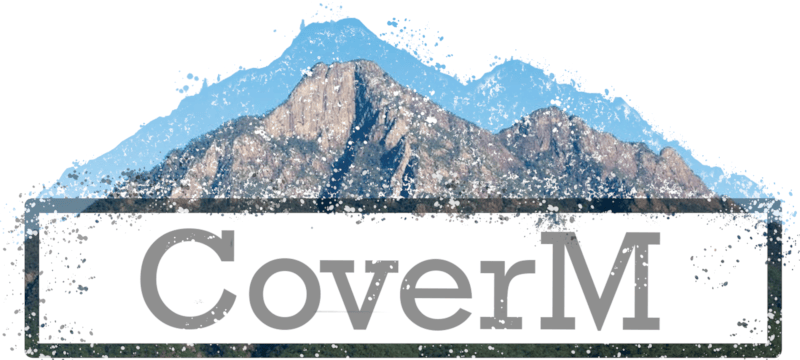10 releases (5 breaking)
Uses old Rust 2015
| 0.7.0 | Jan 18, 2024 |
|---|---|
| 0.6.1 | Feb 24, 2021 |
| 0.6.0 | Dec 10, 2020 |
| 0.5.0 | Aug 28, 2020 |
| 0.2.0-alpha6 | Mar 24, 2019 |
#147 in Biology
60 downloads per month
Used in lorikeet-rs
2.5MB
11K
SLoC

CoverM
CoverM aims to be a configurable, easy to use and fast DNA read coverage and relative abundance calculator focused on metagenomics applications.
CoverM calculates coverage of genomes/MAGs coverm genome (help) or individual
contigs coverm contig (help). Calculating coverage by read mapping, its input can
either be BAM files sorted by reference, or raw reads and reference genomes in various formats.
Installation
Install through the bioconda package
CoverM and its dependencies can be installed through the bioconda conda channel. After initial setup of conda and the bioconda channel, it can be installed with
conda install coverm
Pre-compiled binary
Statically compiled CoverM binaries available on the releases page. This installation method requires non-Rust dependencies to be installed separately - see the dependencies section.
Compiling from source
CoverM can also be installed from source, using the cargo build system after installing Rust.
cargo install coverm
Development version
To run an unreleased version of CoverM, after installing Rust and any additional dependencies listed below:
git clone https://github.com/wwood/CoverM
cd CoverM
cargo run -- genome ...etc...
To run tests:
cargo build
cargo test
Dependencies
For the full suite of options, additional programs must also be installed, when installing from source or for development.
These can be installed using the conda YAML environment definition:
conda env create -n coverm -f coverm.yml
Or, these can be installed manually:
- samtools v1.9
- tee, which is installed by default on most Linux operating systems.
- man, which is installed by default on most Linux operating systems.
and some mapping software:
For dereplication:
Shell completion
Completion scripts for various shells e.g. BASH can be generated. For example, to install the bash completion script system-wide (this requires root privileges):
coverm shell-completion --output-file coverm --shell bash
mv coverm /etc/bash_completion.d/
It can also be installed into a user's home directory (root privileges not required):
coverm shell-completion --shell bash --output-file /dev/stdout >>~/.bash_completion
In both cases, to take effect, the terminal will likely need to be restarted. To test, type coverm gen and it should complete after pressing the TAB key.
Usage
CoverM operates in several modes. Detailed usage information including examples is given at the links below, or alternatively by using the -h or --full-help flags for each mode:
There are several utility modes as well:
- make - Generate BAM files through alignment
- filter - Remove (or only keep) alignments with insufficient identity
- cluster - Dereplicate and cluster genomes
- shell-completion - Generate shell completion scripts
Calculation methods
The -m/--methods flag specifies the specific kind(s) of coverage that are
to be calculated.
To illustrate, imagine a set of 3 pairs of reads, where only 1 aligns to a single reference contig of length 1000bp:
read1_forward ========>
read1_reverse <====+====
contig ...-----------------------------------------------------....
| | | | |
position 200 210 220 230 240
The difference coverage measures would be:
| Method | Value | Formula | Explanation |
|---|---|---|---|
| mean | 0.02235294 | (10+9)/(1000-2*75) | The two reads have 10 and 9 bases aligned exactly, averaged over 1000-2*75 bp (length of contig minus 75bp from each end). |
| relative_abundance | 33.3% | 0.02235294/0.02235294*(2/6) | If the contig is considered a genome, then its mean coverage is 0.02235294. There is a total of 0.02235294 mean coverage across all genomes, and 2 out of 6 reads (1 out of 3 pairs) map. This coverage calculation is only available in 'genome' mode. |
| trimmed_mean | 0 | mean_coverage(mid-ranked-positions) | After removing the 5% of bases with highest coverage and 5% of bases with lowest coverage, all remaining positions have coverage 0. |
| covered_fraction | 0.02 | (10+10)/1000 | 20 bases are covered by any read, out of 1000bp. |
| covered_bases | 20 | 10+10 | 20 bases are covered. |
| variance | 0.01961962 | var({1;20},{0;980}) | Variance is calculated as the sample variance. |
| length | 1000 | The contig's length is 1000bp. | |
| count | 2 | 2 reads are mapped. | |
| reads_per_base | 0.002 | 2/1000 | 2 reads are mapped over 1000bp. |
| metabat | contigLen 1000, totalAvgDepth 0.02235294, bam depth 0.02235294, variance 0.01961962 | Reproduction of the MetaBAT 'jgi_summarize_bam_contig_depths' tool output, producing identical output. | |
| coverage_histogram | 20 bases with coverage 1, 980 bases with coverage 0 | The number of positions with each different coverage are tallied. | |
| rpkm | 1000000 | 2 * 10^9 / 1000 / 2 | Calculation here assumes no other reads map to other contigs. See https://haroldpimentel.wordpress.com/2014/05/08/what-the-fpkm-a-review-rna-seq-expression-units/ for an explanation of RPKM and TPM |
| tpm | 1000000 | rpkm/total_of_rpkm * 10^6 | Calculation here assumes no other reads map to other contigs. See RPKM above. |
Calculation of genome-wise coverage (genome mode) is similar to calculating
contig-wise (contig mode) coverage, except that the unit of reporting is
per-genome rather than per-contig. For calculation methods which exclude base
positions based on their coverage, all positions from all contigs are considered
together. For instance, if a 2000bp contig with all positions having 1X coverage
is in a genome with 2,000,000bp contig with no reads mapped, then the
trimmed_mean will be 0 as all positions in the 2000bp are in the top 5% of
positions sorted by coverage.
License
CoverM is made available under GPL3+. See LICENSE.txt for details. Copyright Ben Woodcroft.
Developed by Ben Woodcroft at the Queensland University of Technology Centre for Microbiome Research.
Dependencies
~39–53MB
~836K SLoC
